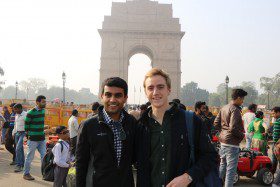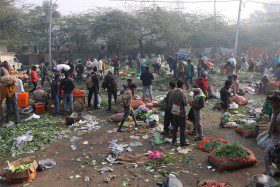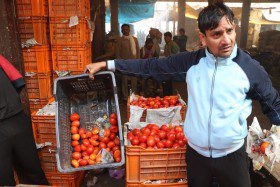 By Naren Tallapragada, Harvard Graduate School of Arts and Sciences and Francesco Wiedemann, MIT
By Naren Tallapragada, Harvard Graduate School of Arts and Sciences and Francesco Wiedemann, MIT
Tallapragada and Wiedemann were winners of SAI’s inaugural 2016 Seed for Change Competition for gomango, which provides low-cost refrigerated transport to food producers in India. Since the spring, they have been working to implement their idea on the ground in India
In December 2016 we visited India to start building our business (gomango) enabled by a Seed for Change grant from the South Asia Institute. On our trip we met players in food, retail, and logistics across the country who were excited by our vision to make cold chains in India affordable and sustainable. Our journey took us from the fish docks of Mumbai and food factories of Aurangabad to the wholesale markets of Delhi and office parks of Bangalore. Along the way we tested our technology and gained valuable insight into the psychology of Indian consumers and corporations.
As the inaugural winners of the Seed for Change competition and active members of the entrepreneurial ecosystem at Harvard, we have been able to take our venture further and faster. By sharing our learnings and our progress in this post and ones that follow, we hope to give back to the community that has supported us so generously.
 Nothing you read or watch on TV can prepare you for the reality of being in India. As a German coming to India for the first time in his life, Francesco had an eye-opening experience. In his own words: “It was amazing to see how big the differences really are between the developed and developing world. In India cars and pedestrians follow no rules. A political procession can cause an hours-long traffic jam. The sky in many cities is choked by smog, an indicator of India’s tremendous economic growth and the profound environmental problems that accompany it. Yet for all of its challenges India is one of the world’s friendliest and most hospitable societies. Though I looked like an outsider I never felt like one. I was impressed by how even casual acquaintances were willing to connect us with their old friends and business partners – of course, stuffing us with food before we left any meeting!”
Nothing you read or watch on TV can prepare you for the reality of being in India. As a German coming to India for the first time in his life, Francesco had an eye-opening experience. In his own words: “It was amazing to see how big the differences really are between the developed and developing world. In India cars and pedestrians follow no rules. A political procession can cause an hours-long traffic jam. The sky in many cities is choked by smog, an indicator of India’s tremendous economic growth and the profound environmental problems that accompany it. Yet for all of its challenges India is one of the world’s friendliest and most hospitable societies. Though I looked like an outsider I never felt like one. I was impressed by how even casual acquaintances were willing to connect us with their old friends and business partners – of course, stuffing us with food before we left any meeting!”
Speaking of food – we set off for India to test many of the assumptions and hypotheses underlying our business plan. First and foremost was the headline number we have always used to make a case for our vision: 40% of food in India spoils on its way from farm to market. We confirmed this number with supermarket chains, distributors, food brands, and retail experts. However, we learned that in India spoiled food is not necessarily wasted food. There is a secondary market or use for most damaged and expired goods that would go to waste in the West, in part because food safety standards are lightly enforced.
 We saw this parallel market in action at the Ohkla sabzi mandi in Delhi. One seller we met had many grades of tomatoes on offer. He sells fresh, red “grade A” tomatoes to supermarkets and kirana stores, while partly green “grade B” tomatoes go to hotels and restaurants that use them to prepare meals. But even his spoiled tomatoes have a buyer. When we asked this seller what he does with his food “waste,” he showed us another crate hidden under a table at his stall. In this crate we could see (and smell) mushy, runny, rotten tomatoes. To our (unpleasant) surprise the seller told us that street food vendors buy these tomatoes at bargain-basement prices and use them in soups, sauces, and gravies.
We saw this parallel market in action at the Ohkla sabzi mandi in Delhi. One seller we met had many grades of tomatoes on offer. He sells fresh, red “grade A” tomatoes to supermarkets and kirana stores, while partly green “grade B” tomatoes go to hotels and restaurants that use them to prepare meals. But even his spoiled tomatoes have a buyer. When we asked this seller what he does with his food “waste,” he showed us another crate hidden under a table at his stall. In this crate we could see (and smell) mushy, runny, rotten tomatoes. To our (unpleasant) surprise the seller told us that street food vendors buy these tomatoes at bargain-basement prices and use them in soups, sauces, and gravies.
We did not expect that anyone derived value from waste that we had considered worthless. But they do. We had to see India for ourselves to turn the business plan we wrote in Cambridge into a plan of action that could work in Chennai. As the saying goes, “in theory, there is no difference between theory and practice. In practice, there is.”
